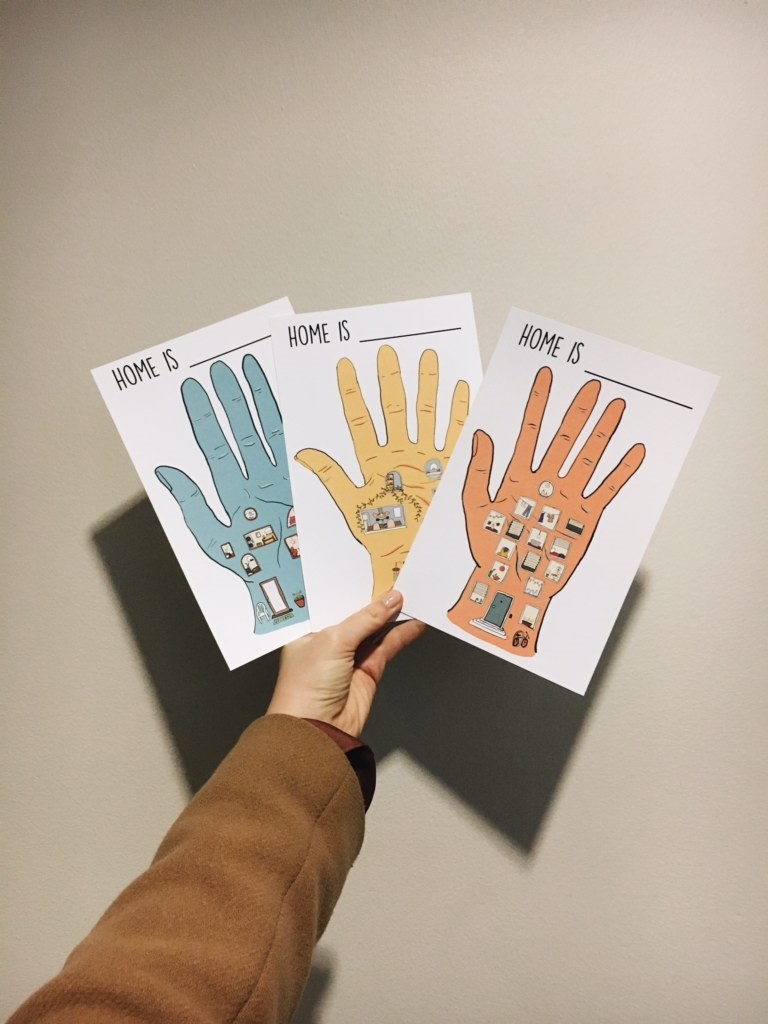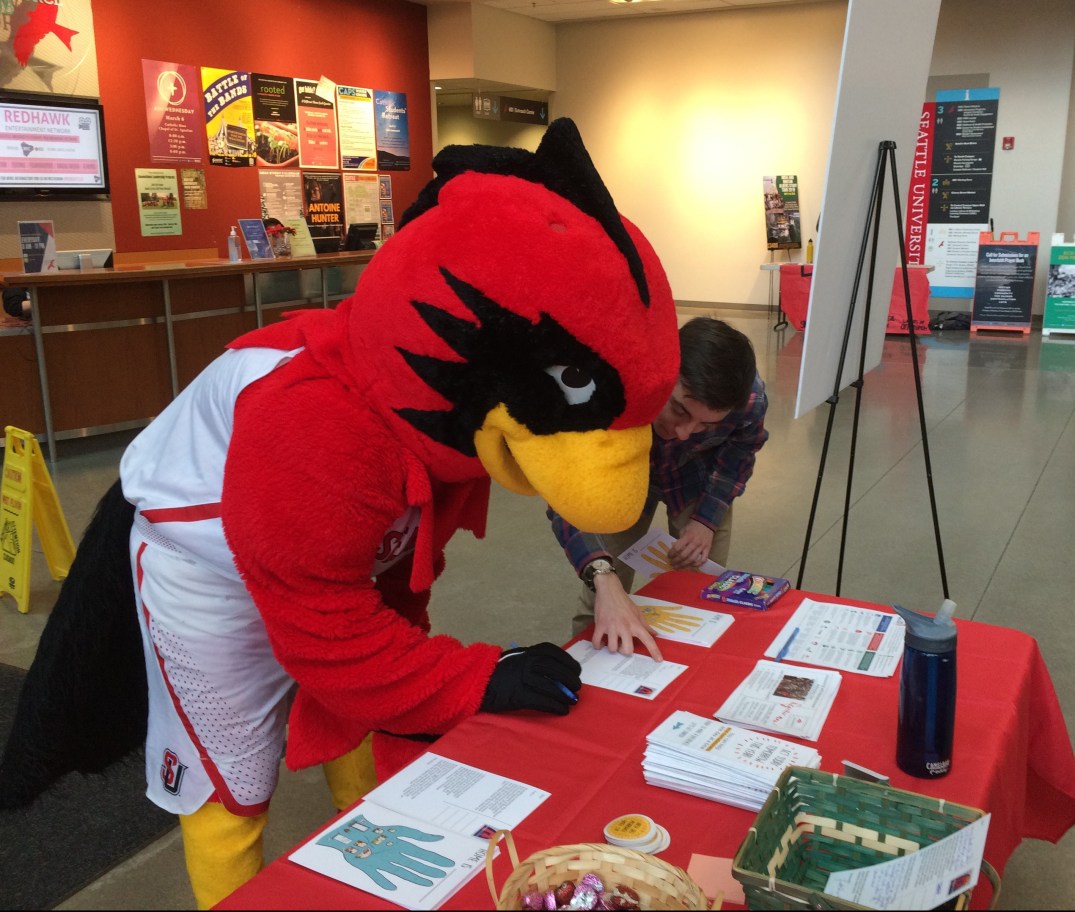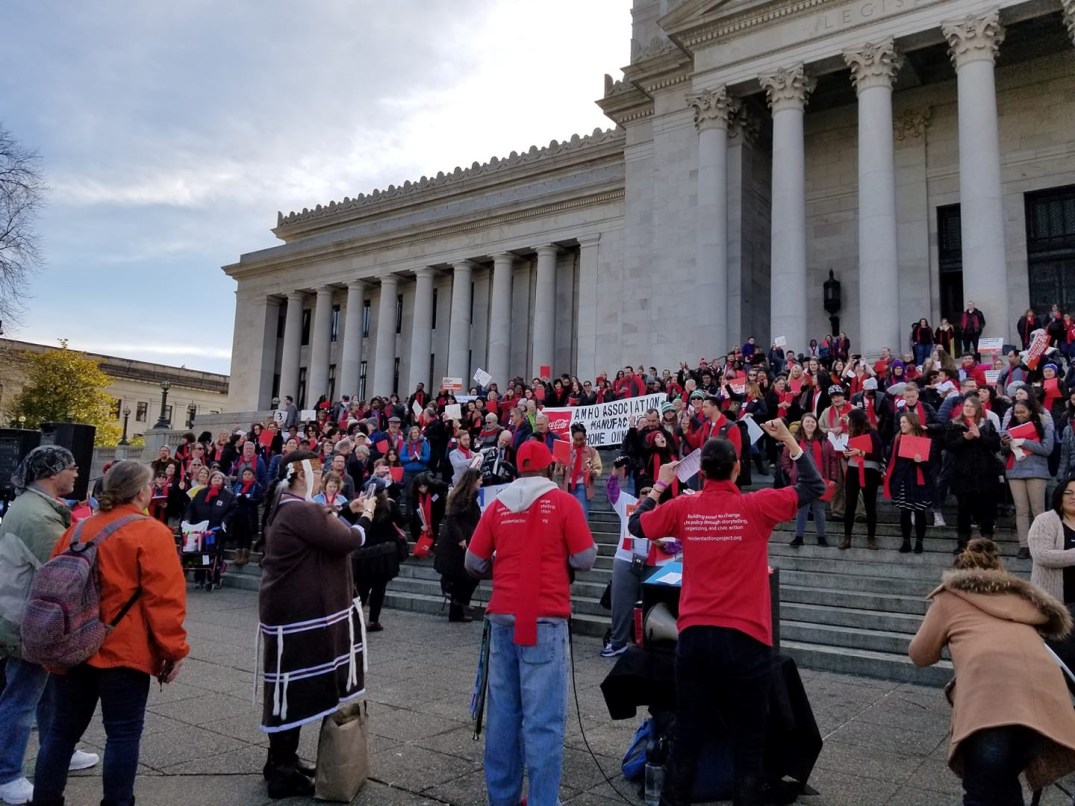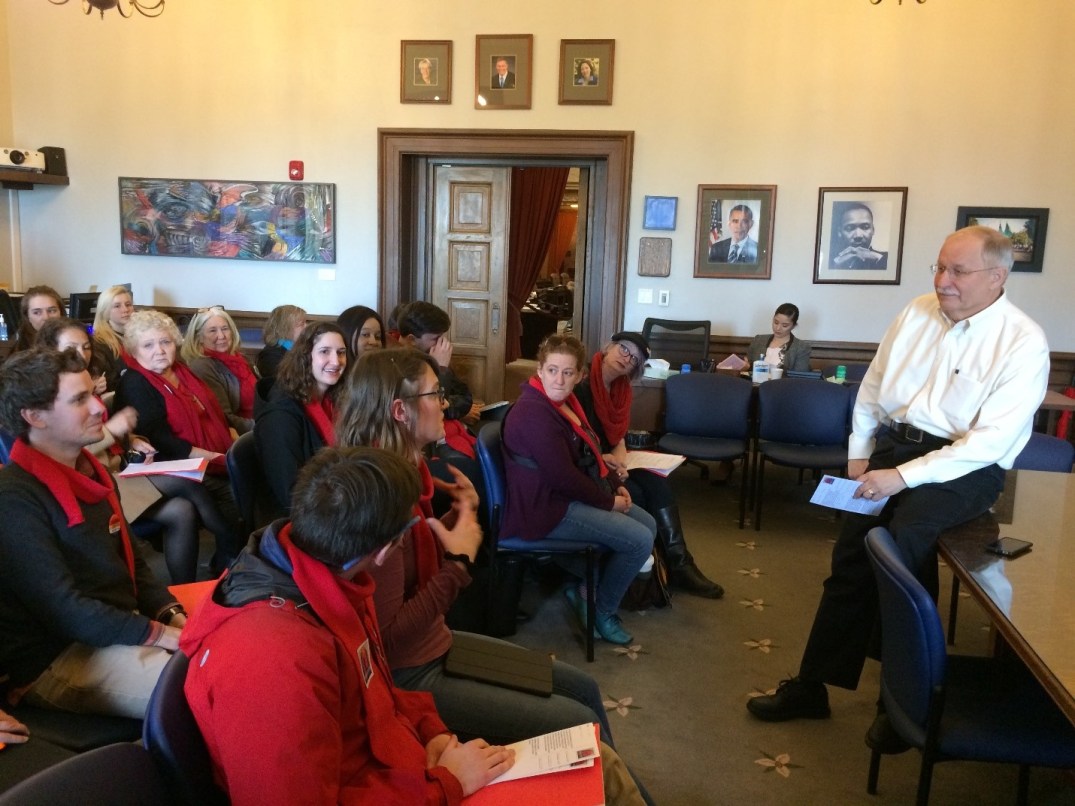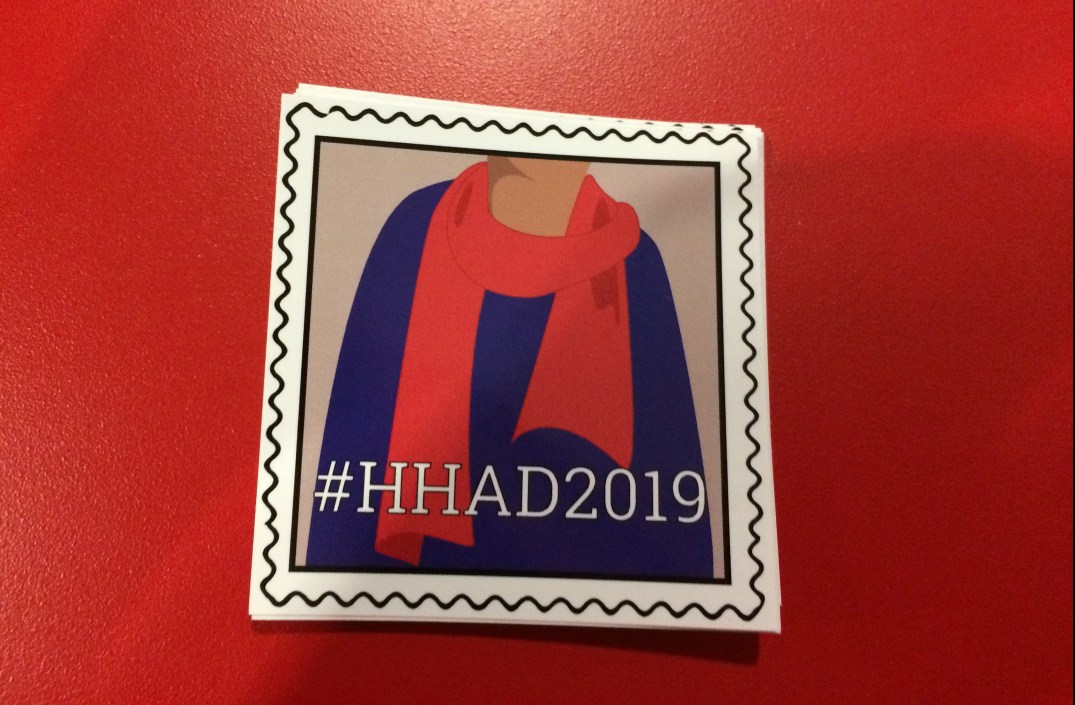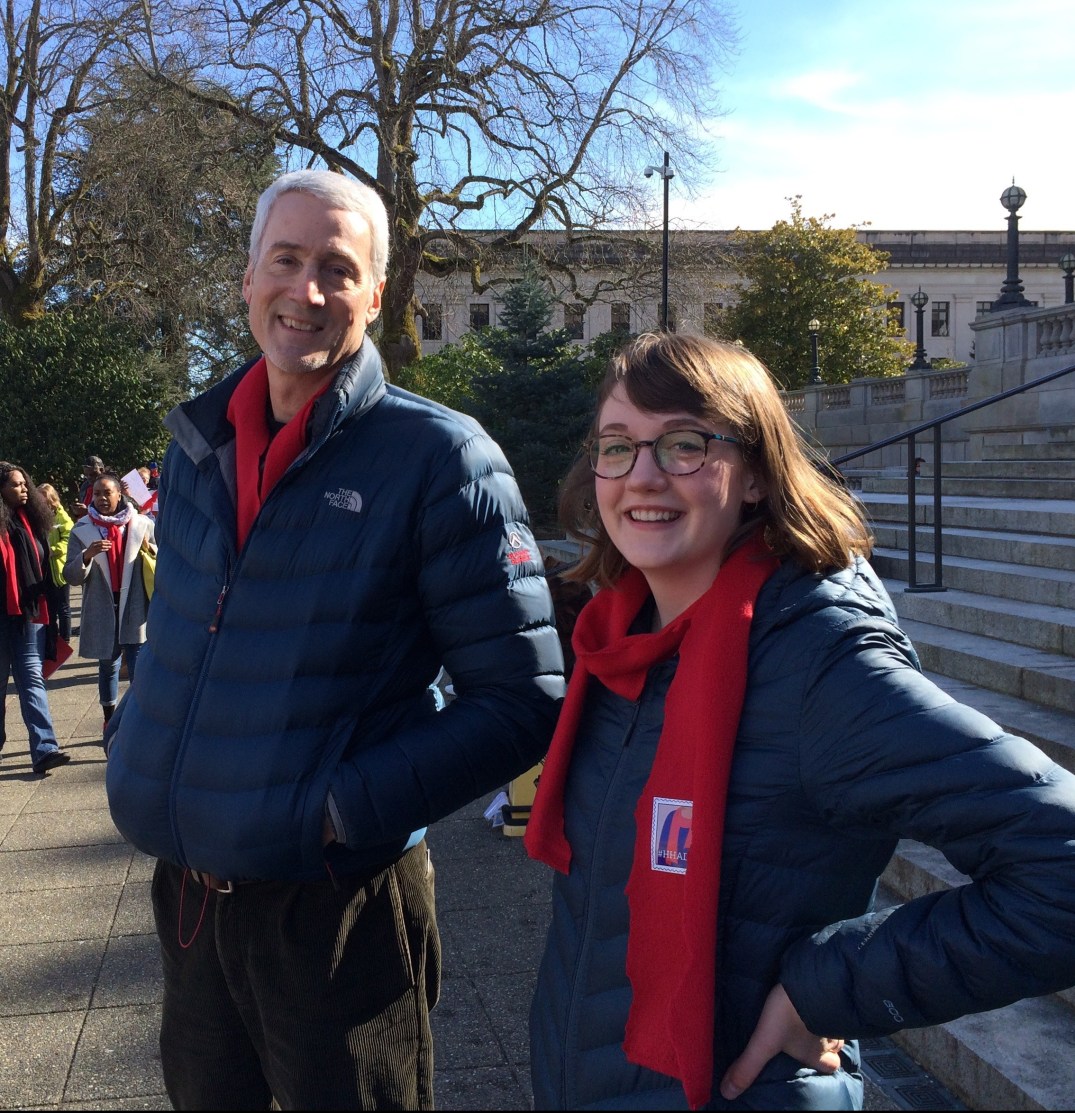By Mary Lacey, Project Assistant, Seattle University’s Project on Family Homelessness

Introduction: In the midst of a pandemic and great controversy, Wisconsin held its primary election April 7. Though the governor wanted to delay the election till June, the Wisconsin Supreme Court ordered the election to proceed and the U.S. Supreme Court ruled that all absentee ballots – including those newly requested as a way to safely vote — were due by Election Day. The situation was chaotic for our new grad, Wisconsin native Mary Lacey, who had flown back home after finals week, about two weeks earlier.
Seattle University’s winter quarter was ending right as our campus was closing March 20; and many students had returned home to quarantine with their families, and/or to take their spring quarter classes from home. Voting might have been the last thing on the minds of many. But for Mary, who comes from a family devoted to civic engagement, whether – and how — to vote became a complicated and critical decision. I asked her to share her experience. – Catherine Hinrichsen, project director
Have you voted absentee your whole time as a student at Seattle U? Why did you want to vote in Wisconsin elections instead of Washington?
I’ve voted absentee my entire college career, and I vote in my home state of Wisconsin because I feel a greater draw towards Wisconsin elections. I even voted absentee from Prague, Czech Republic, where I was studying abroad.
I intended to vote absentee for this election too. But that fell apart due to circumstances around COVID-19 and the battle over voting in person that made the Wisconsin election so controversial.

Wisconsin is a swing state where results vary between two parties, versus Washington where one party tends to hold the majority consistently. Voter suppression is an issue in Wisconsin; state law requires a valid Wisconsin ID to vote, prohibiting those without access to an ID from exercising their right to vote. Additionally, gerrymandering and limiting early voting has actively deterred people from voting.

Because my family has lived and worked in Wisconsin for generations, I feel a connection to the issues this state faces and hold onto my identity as a Wisconsin resident
Does your family have a strong commitment to voting? If so, why?
My family does have a strong commitment to voting, which has influenced my attitudes towards voting and politics. My family has always been passionate about political issues on a national and local level as we strongly believe in civic engagement. My grandfather was a factory worker who was active in his union. He passed along his political participation to his children, who then passed it onto the current generation. Many of my family members continuously contact their local representatives to get their voices heard, attend rallies, and vote in every election. Additionally, several of my family members work for the government and witness the importance of political participation.
My family knows that it is a great privilege to vote, and we do not take it for granted.
When did you first start voting? Do you remember any candidate or issue that you voted for then?
I first voted in person for the presidential primary in April 2016 as a senior in high school (exactly four years ago this month!). It was exciting to vote in person alongside my family, who have been influential in my interest in politics. I remember being passionate about the presidential candidate I voted for because I had attended their rallies and was active in their campaign. I also remember voting for a State Supreme Court justice race as well, because I have in interest in the court system’s role in our government. Although it is exciting to vote in a national election, I felt equal excitement voting for local positions – the “down-ballot” races. It was special to finally demonstrate my political power through the important act of voting.
What were some of the significant issues and candidates on the Wisconsin ballot?
The most important issue for me was voting in the Wisconsin Supreme Court race. There was a lot of attention around this position due to involvement of the state and U.S. Supreme Court in allowing the election to happen.
The day before the election, the Wisconsin Supreme Court overruled the Governor’s executive order to cancel the election despite being in the midst of a pandemic. Additionally, the U.S. Supreme Court overruled a federal judge’s ruling to allow absentee ballots to be turned in by April 13, instead of Election Day, April 7. Thus, all absentee ballots were due by Election Day, and these decisions were made the night before Election Day, creating confusion among voters.
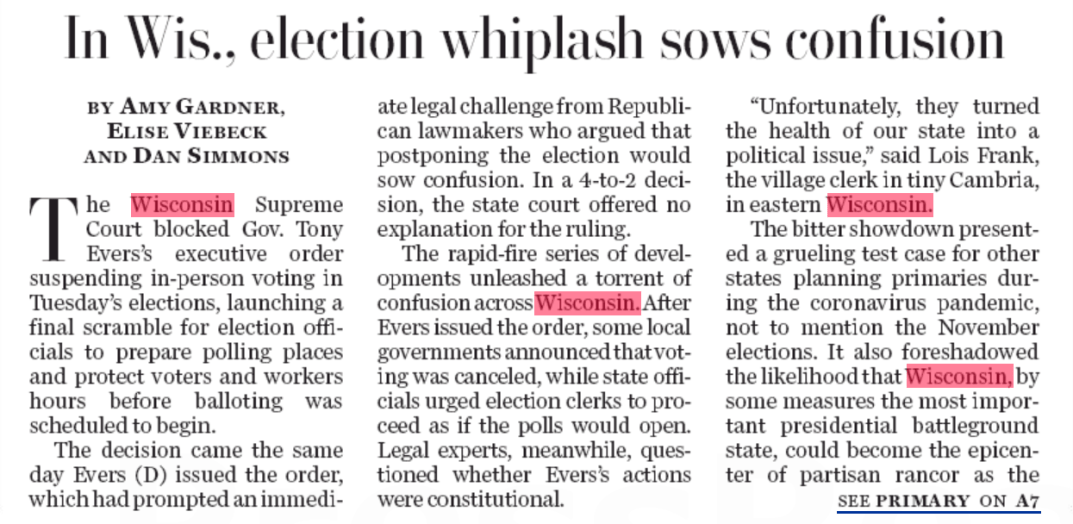
Two other important races for me were the Milwaukee County Executive position and mayoral race. Additionally, there were two referendums on the ballot including Marsy’s Law, legislation being proposed in many states regarding victims’ rights [Washington is not one of the states]; and a Milwaukee County referendum to have a non-partisan party draw legislative districts. Although it was a presidential primary, I felt more compelled to vote by the local issues at play.
Your absentee ballot had been sent to Seattle, and you couldn’t get another. When did you realize you would have to vote in person? What were your concerns?
I realized I had to vote in person the day before the election, when I didn’t receive my absentee ballot in time to be counted for the election. I had thought at least if it came the day before, I could go drop it off at City Hall, instead of going in to vote or sending it by mail (which would have been too late per the U.S. Supreme Court’s ruling when absentee ballots were due).

I was concerned about my health and the health of those I live with, as my parents are at-risk. Mostly, I was concerned for the poll workers who had to be at the polls all day, especially since a large percentage of Wisconsin’s poll workers are elderly. Even though the news said they would have PPE and take precautionary measures, I still felt uneasy about going to vote.
Did you consider not voting? What made you decide to go ahead with voting?
Yes, I did consider not voting. Because of my commitment to voting and a desire to vote out the people who allowed this election to happen, I felt compelled to vote. Fortunately, the rest of my family received their absentee ballots in time, so they were able to vote without going in person and were supportive of my decision to go in to vote.
The night before Election Day, we still didn’t know if the election would go forward. When the Supreme Court ruled that it should, I still wasn’t sure if I was going to go vote. But I set an early alarm, so if I did decide to vote, I would go right when the polls opened.
Describe the morning of voting. What was it like waiting in line? What safety measures were in place?
The morning of, I decided to go vote in person, as I felt it was the right decision based on the circumstances. I felt anxious to leave my house during the pandemic. I hadn’t voted in person since 2016, so I was nervous about the process; my polling place had changed since I first voted, and I didn’t have my family members with me who knew the process well. Although I tried to prepare by reading information online and asking my family member how the process worked, so that I could minimize my amount of time in the polling place and my contacts with others, I still was confused and worried when I arrived at my polling place.
Even though I was one of the first people to arrive at my polling site, more people were there than I expected. Because many districts vote at my polling place, there was a significant number of people waiting at 7 a.m. when the polls opened. I was lucky that I did not have to wait outside, but I did wait about 15 minutes inside. As I was leaving, there was a line forming outside.

In the city of Milwaukee, there were only five polling locations available for a city of over 500,000 people (there are usually 180 sites open). At some locations, voters reported waiting outside for three hours to vote. The Milwaukee Election Commission reported that over 18,000 people in the city voted in person on Election Day. Milwaukee faced the most confusion and frustration from a shortage of poll workers, which limited the amount of polling locations available in the city and significantly impacted the Latinx and African American communities. Although over one million absentee ballots were requested, thousands of people reported never receiving theirs, and had to make the decision to not vote or risk their health by voting in person.
As I waited, I tried to keep my distance from others. I had to ask polling staff which room my district was in, because there were multiple places within the building that were split up by wards without proper signage indicating where to go. I eventually found my room, which included two other wards in addition to mine. There were a lot of people for the size of the room, which I was surprised to see. Every poll worker was wearing a mask and gloves, along with some other voters who decided to wear personal protective equipment (PPE). However, it was very difficult to keep a safe six-foot distance from others.
At my ward’s check-in table, there was Plexiglass between the two workers behind the glass and me. I had to show them my ID by placing it up against the glass so they could read my name and address. At first, they were confused because on their records it showed I had requested an absentee ballot, so they were unsure if they were allowed to give me a ballot. I explained that I never received my ballot, and they had to confirm with another poll worker and eventually decided that it was ok to give me a ballot.

I brought my own pen to fill out my ballot at the booth; however, the booths were not six feet apart, again leaving it impossible to keep a safe distance from others. Additionally, the room only had a small entryway, so those entering and leaving could not keep their distance.
There were National Guard members helping people in line and trying to keep people safe by distributing hand sanitizer and cleaning surfaces. Wisconsin is a state that allows same-day voter registration [as does Washington], so there was still a designated room for non-registered people to go vote in; this room was way bigger and emptier than the room I voted in.
Overall, I felt uneasy about the experience as I was worried I had exposed myself to others, and them to me. When I got home, I took a long shower to try to feel better and contemplate what had just happened.
What do you recommend to policymakers about voting policy now?
I recommend that policymakers adopt universal mail-in voting. From what I see in Washington state, which has adopted this policy, it makes the most sense in terms of public safety (as the coronavirus continues to impact the world) and from an equity standpoint. For those not able to take off work to vote, have a disability restricting them to vote, or not being able to get to polling places, mail-in voting shows to increase voter turnout by eliminating barriers for people to vote. Additionally, I urge policymakers to have compassion during these troubling times by prioritizing public health and helping struggling residents be able to live and stay healthy.
Do you think people your age are as committed to voting as you are?
Although historically young people have the lowest rates for voter turnout, I think there is an increasing interest in politics among youth. I think especially during this public health crisis, young people are seeing the importance of our elected officials from a federal to local level. Additionally, with the rise of social media in the engagement of candidates to young people and display of social issues has encouraged youth civic engagement. Despite feelings of distrust in our institutions, I think now is a crucial moment in our history to pay attention to the actions of our government.
Are you glad you voted?
Yes, I am glad I voted, but I do feel some guilt that I went in person to vote. Although I tried to vote safely by wearing a mask, bringing hand sanitizer, and trying to keep my distance, I feel guilty that I potentially put my family, other voters, and poll workers at risk. Although I feel a great responsibility to vote, I also feel a great responsibility to contain the coronavirus.
I am not alone in this feeling, as thousands of other Wisconsinites had to make a decision between demonstrating democracy and protecting public health. This responsibility is on our elected officials who did not protect peoples’ health or right to vote by allowing the election to happen.

Hopefully, this will inspire voters who were not motivated to vote in local elections to vote for positions including court justices, mayors, county executives, school board members and other important roles that are often overlooked. Although the circumstances of this election did not protect the safety of Wisconsinites, I hope the situation sparked interest in voters to pay attention to local politics and participate in civic engagement.
What You Can Do:
- Register to vote. In Washington: here. Nationwide: here.
- Look into organizations that are working to protect voting rights.
- Then, vote!
Update: As of April 24 – more than 14 days after the election — Mary and her family are healthy and we hope they stay that way. However, as of that same date, 40 cases of COVID-19 in Milwaukee County had been traced to Election Day. We wish a full recovery to those who exercised their right to vote, and the poll workers and others who helped them do it.
